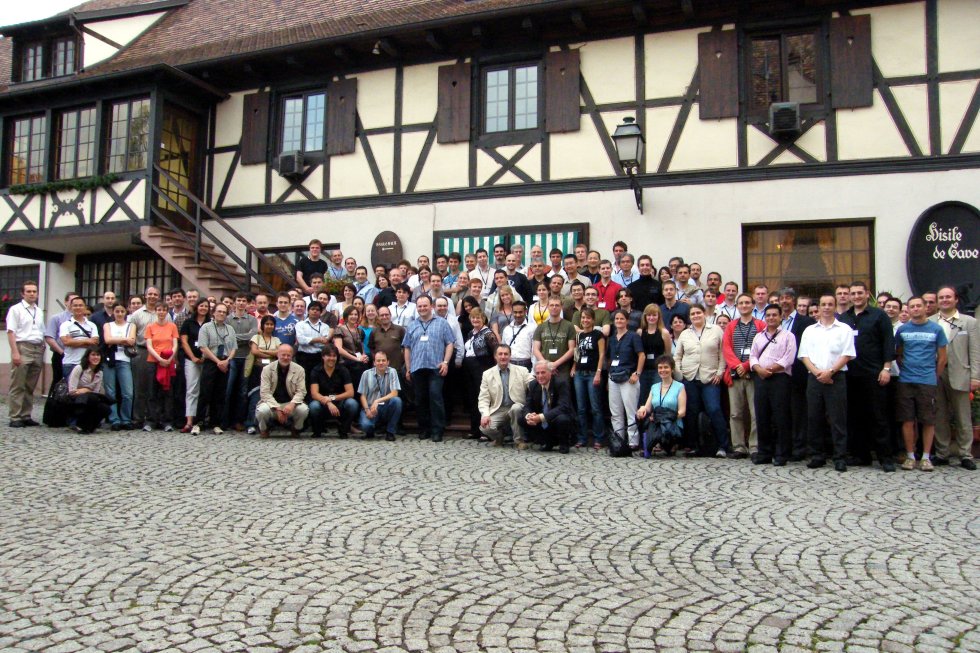| ID |
Title |
Authors |
| 1 |
"Grider", a visual data mining tool for inspection of chemical spaces. Extension to diversity exploration. |
Alban Arrault, Véronique Hamon, Philippe Vayer, Marc Bertrand |
| 2 |
New guided docking approaches for virtual screening and drug design |
M. Bhattacharyya, J. Seco, F. J. Luque, X. Barril |
| 3 |
Statistical Approach of Structure-Activity Relationships: A Case Study |
Sorana D. Bolboacă, Lorentz Jäntschi |
| 4 |
Ligand Unbinding from the Estrogen Receptor; A theoretical study of molecular mechanics and specificity |
Sofia Burendahl, Lennart Nilsson |
| 5 |
A computational chemistry application of the Kepler scientific workflow platform |
J. M. Campanera Alsina, X. Barril, F. J. Luque |
| 6 |
SAMFA: how much can we simplify molecular description without sacrificing predictive ability of 3D-QSAR models? |
John Manchester, Ryszard Czerminski |
| 7 |
Selective virtual screening for partial and full agonists in the beta2 adrenergic receptor crystal structure |
Chris de Graaf, Didier Rognan |
| 8 |
Embedded Molecular Geometry and Molecular Topology Approach for Structure - Activity Relationships |
Lorentz Jäntschi, Sorana D. Bolboacă |
| 9 |
Chemoinformatics module for CMKb, a Customary Medicinal Database |
Varun Khanna, Jitendra Gaikwad , Joanne Jamie , Shoba Ranganathan |
| 10 |
An integrated methodology to interface structure- and ligand-based drug design |
Ilenia Giangreco, Orazio Nicolotti, Teresa Fabiola Miscioscia, Paola Tedeschi,Andrea Carotti, Francesco Leonetti, Angelo Carotti |
| 11 |
An Artificial Neural Network Approach to Pre-screening of Large Chemical Datasets |
Gohar Margaryan, Rick Stevens |
| 12 |
Graph representation of molecular datasets: applications to dataset visualization and comparison using graph indices. |
Denis Fourches and Alexander Tropsha |
| 13 |
Design of high affinity inhibitors of DNA polymerase beta by virtual screening and NMR |
Corinne Hazan |
| 14 |
Comparative Structural and Energetic Analysis of Receptor-Ligand Interactions |
S. Henrich, S. Richter, T. Wang, R. R. Gabdoulline, R. C. Wade |
| 15 |
Multicomponent QSPR in Estimation of Rate of Nucleophilic Substitution at Saturated Carbon |
Karpov P.V., Kravtsov A.A., Baskin I.I., Palyulin V.A., Zefirov N.S. |
| 16 |
Similarity for reaction using the concept of Condensed Graph of Reaction. |
F. Hoonakker, A. Varnek |
| 17 |
Data Integration and Knowledge transfer: Application to the tissue:air partition coefficients |
Cédric Gaudin, Gilles Marcou, Philippe Vayer, Igor Baskin, Anil Kumar Pandey, Igor Tetko, Alexandre Varnek |
| 18 |
Ensemble approach to applicability domains of SAR/QSAR models. |
N. Kireeva, G. Marcou, A. Varnek, I. Baskin, K. Migita, M. Arakawa, K. Funatsu |
| 19 |
COMET - Predictive Tool to Assess Stability of Metal Complexes in Solution. |
N. Kireeva, G. Marcou, V.P. Solov’ev, D. Fourches, O.Klimchuk and A.Varnek |
| 20 |
Application of Molecular-Similarity Networks for Chemoinformatics Research |
Zsolt Lepp, Chunfei Huang, Takashi Okada |
| 21 |
Different Handling of a Hydrophobic Pocket and Consequences for Screening Results in Catalyst, Phase and MOE |
Gudrun M. Spitzer, Martina Mangold, Theodora M. Steindl, Hannes G. Wallnoefer, Christian Laggner, Thierry Langer, Klaus R. Liedl |
| 22 |
MMsINC®: a new public large-scale chemoinformatics database system |
J.Masciocchi, M.Fanton, M. Floris, G. Frau1, M. Sturlese, P. Palla1, F. Cedrati, S.Moro, P. Rodriguez-Tomé |
| 23 |
Integration Framework to Build Powerful Applications for Pharmaceutical Research |
Aurélien Monge |
| 24 |
HiT QSAR Modeling of Chemical Toxicants Tested against Tetrahymena pyriformis |
Eugene N. Muratov, Kun Wang, Alexander Golbraikh, Victor E. Kuz’min, Anatoly G. Artemenko, Leonid Gorb, Mohammad Quasim, Jerzy Leszczynski, Alexander Tropsha |
| 25 |
Expanding the small-molecule GDB with focused libraries of ligands for glutamate receptors |
Kong Thong Nguyen, Jean-Louis Reymond |
| 26 |
GemsBond : an algorithm for discovering synthesizable bonds in molecular graphs. Application to the retrosynthetic analysis |
Frédéric Pennerath, Philippe Jauffret, Claude Laurenço, Gilles Niel, Philippe Vismara and Amedeo Napoli |
| 27 |
SiteAlign: a simple and fuzzy method to measure similarity between binding sites |
C. Schalon, J.-S. Surgand, E. Kellenberger, D. Rognan |
| 28 |
Glide XP fragment docking and structure-based pharmacophores |
Sherman W., Friesner R. |
| 29 |
Analysis of DNA Minor Groove Binding Patterns |
Gudrun M. Spitzer, Bernd Wellenzohn, Patrick Markt, Johannes Kirchmair, Thierry Langer, Klaus R. Liedl |
| 30 |
Development of Multi Component Molecular Theory and its Application |
Masanori Tachikawa |
| 31 |
Determination of 2D pharmacophore with a new algorithm for determining emerging patterns. Application to 5-HT7 ligands. |
Thibault Varin, François Rioult, Ronan Bureau, Sylvain Rault |
| 32 |
Monoamine ligands binding to the dopamine, norepinephrine and serotonin transporters : through ionic interactions or sodium chelation ? |
Henri Xhaard, Mark S. Johnson |
| 33 |
The Novartis Kinase Compendium : Overview and Applications |
Eric Vangrevelinghe, Nikolaus Stiefl, Greg Landrum and Pascal Furet |
| 34 |
Development of new in silico methods to identify ligands for orphan GPCRs. |
N. Weill, D. Rognan |
| 35 |
Discovery of potent and selective inhibitors of serine acetyltransferase, an enzyme unique to Entamoeba histolytica |
Subhash M. Agarwal, Alok Bhattacharya, Amir Azam |
| 36 |
Conformational sampling and Docking by a GRID-deployed genetic algorithm |
Alexandru-Adrian Tantar, Sébastien Conilleau, Benjamin Parent, Nouredine Melab, Lorraine Brillet, Sylvaine Roy, El-Ghazali Talbi and Dragos Horvath |
